Affiliate disclosure: This post may contain affiliate links. Please see our Privacy Policy.
Shelf-stable food can be a real lifesaver when fresh groceries are not readily available. Most perishable groceries have shelf-stable equivalents, and it’s just a matter of knowing where to find them and how to use them.
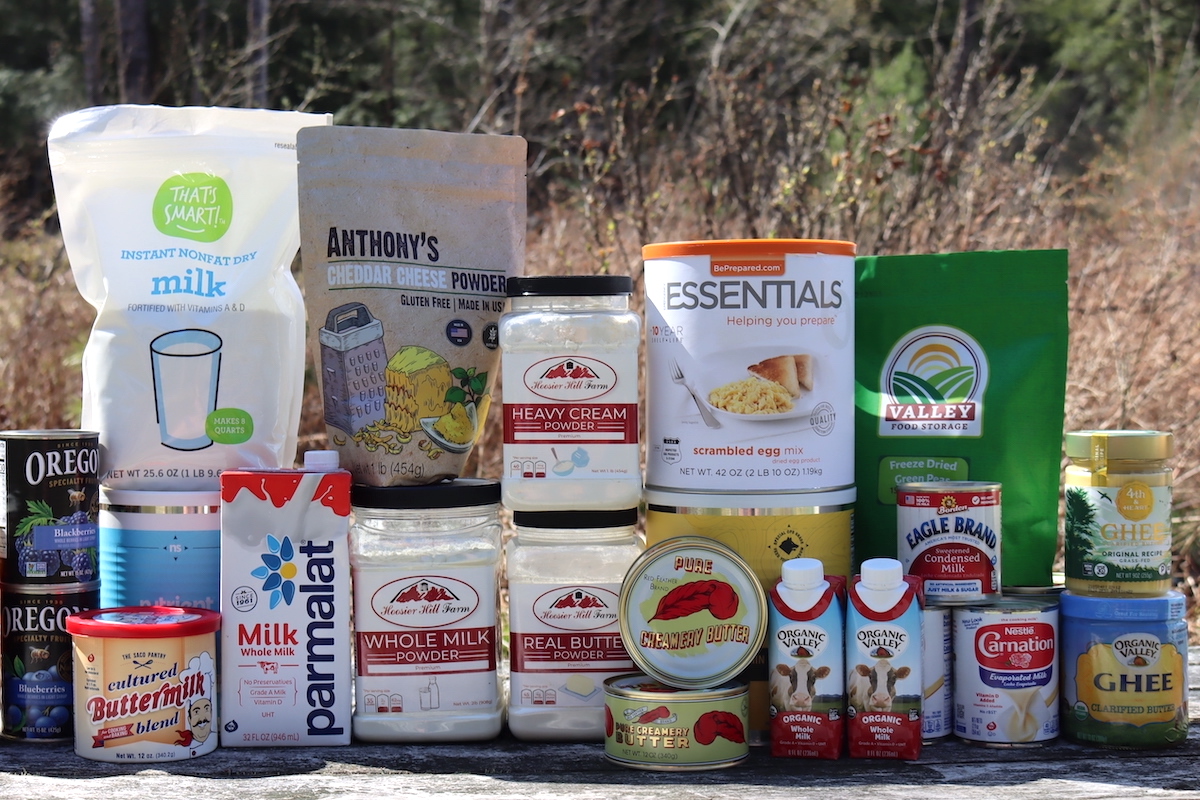
Table of Contents
Food storage used to be a way of life, and as little as a hundred years ago settlers would pack in for the winter with everything they needed to survive. They’d go months at a time without leaving the homestead, all the while eating from their homestead pantry stores.
The advent of refrigeration and international shipping changed all that, and now we’re used to enjoying fresh strawberries in January.
Then when spring of 2020 hit, we all learned the value of having a deep pantry. Just popping out to the store for milk didn’t seem like such a good idea, and as the year wore on, many of the perishables simply weren’t available.
Supply chain issues continue to cause gaps in store shelves, especially around perishable items like milk, butter, cheese, eggs, and meat.
As I write this in spring 2022, we’re experiencing a local milk shortage, not because of lack of production…but because there’s no one to truck the milk from the farms to the bottling plants.
Eggs and cheese have faced similar challenges, even when there’s technically plenty produced.
Local emergencies like hurricanes and ice storms here in Vermont have knocked out roads for weeks at a time, leaving some communities completely on their own (and without power for refrigeration).
Shelf-stable versions of perishable pantry ingredients help ensure that you’ve got plenty on hand to feed your family, even if the grocery store shelves are bare. Be it temporary, for just a few days or weeks, or in a longer-term crisis.
There are shelf-stable versions of most common perishable ingredients, from butter and milk to cheese and eggs, and even meat. In most cases, there are multiple options from dried, to freeze-dried and canned.
Each has its pros and cons, and I’ll walk you through all the options one by one. If you’re looking for a quick answer, here’s a list of some of the most common options available:
- Milk (and Other Liquid Dairy)
- UHT Milk (and UHT Coffee Creamer)
- Dried Milk Powder
- Dried Cream Powder
- Dried Buttermilk Powder
- Dried Yogurt Powder
- Dried Sour Cream Powder
- Eggs
- Dried Egg Powder (for baking)
- Freeze Dried Scrambled Eggs (pre-cooked)
- Butter
- Clarified Butter
- Ghee (different than clarified butter)
- Butter Powder (added to clarified butter to put back in the milk solids)
- Cheese
- Freeze Dried Cheese
- Homemade Cheese (made from dried milk)
- Dried Cheese Powder
- Canned Cheese
- Meat
- Home Canned Meat
- Commercially Canned Meat
- Freeze Dried Meat
- Dried Meat (Jerkey)
- Salt Cured Meat
- Fruit
- Freeze-Dried Fruit
- Dried Fruit
- Home Canned Fruit
- Commercially Canned Fruit
- Vegetables
- Freeze-Dried Vegetables
- Dried Vegetables
- Home Canned Vegetables
- Commercially Canned Vegetables
Ways to Make Shelf Stable Food
Many foods are naturally shelf-stable, and white flour, pasta, sugar, and beans will store for years if properly packaged. Other foods are incredibly perishable and require refrigeration (or freezing) to last more than a few hours.
Even still, they’ll spoil in the refrigerator, usually in about a week or two.
There are a number of ways to turn perishable groceries into shelf-stable pantry ingredients, where they’ll last for years (or decades) depending on the preparation.
Dehydrating
One of the simplest ways to make food shelf-stable, dehydration removes water so bacteria can’t spoil the food. It works best for fruits and vegetables, which can be rehydrated or eaten as is.
Heat is used in dehydrating, causing the flavor to change and while you can rehydrate dried food, the texture will never be the same.
Meats, eggs, and cheese can also be dehydrated, but quality suffers and they’ll never be quite the same as their fresh equivalents.
Dehydrating is relatively easy to do at home, provided you plan ahead. I use my Excaliber dehydrator, but you can also use your oven, and there are plenty of dehydrator recipes out there.
Dehydrated food generally lasts 2 to 3 years, or less if it’s meat or dairy. The enzymes are still active in the food, and some moisture remains, so dehydrated food isn’t meant for long-term storage beyond a few months to years.
Freeze Drying
A better alternative than dehydrating, freeze-dried food rehydrates to more or less exactly the same shape, texture, and flavor as the original.
Freeze drying first freezes the food, which creates a scaffolding of ice inside the food. Vacuum pumps then pull out the moisture, but food retains its shape, size, and texture once rehydrated.
Unlike dehydrated food which tastes different and spoils in a few years, freeze-dried food will be as good as the day it was processed even after 25+ years in storage.
There are a number of ways to freeze dry food at home, but the most effective is a home freeze dryer.
Commercially made freeze-dried food is readily available, from brands like Valley Food Storage and Emergency Essentials, as well as half a dozen others.
There are freeze-dried versions of almost every imaginable perishable food, even freeze-dried cheese that rehydrates perfectly to top a pantry pizza. Butter is the exception, as it doesn’t freeze-dry well.
Canning
Canning works well for foods that will be cooked anyway, like meats and soups. Home-canned meat is usually tender and delicious, and soup canning recipes mean you can put a meal in a jar easily.
Low-acid foods like meat, vegetables, and soup will require pressure canning, but pickles, jams, and fruits are preserved with simple water bath canning.
Milk, butter, eggs, and cheese cannot be canned at home safely. They require special equipment, and glass canning jars can’t take the high temperatures (and rapid temperature changes) that are required for canning dairy products safely while maintaining quality.
There are commercially packed options, put up using big industrial canners and more resilient tin cans.
Shelf Stable Versions of Perishable Ingredients
Most perishable ingredients have multiple different shelf-stable equivalents, but they’re not all equal. Some are much easier to use, some taste better, and some store longer than others.
I’ll go through all the options for each perishable ingredient and let you decide what works best for your family.
Shelf Stable Milk
Perhaps the most perishable ingredient in our fridge, it’s used not only fresh but also incorporated into baking.
My kids drink a lot of milk, and I need it for my morning coffee. You’ll notice I said need, not want…there’s a distinction, and some things just aren’t optional.
We make cheese and yogurt at home with fresh milk as well, so putting backup dairy on our pantry shelf is a high priority.
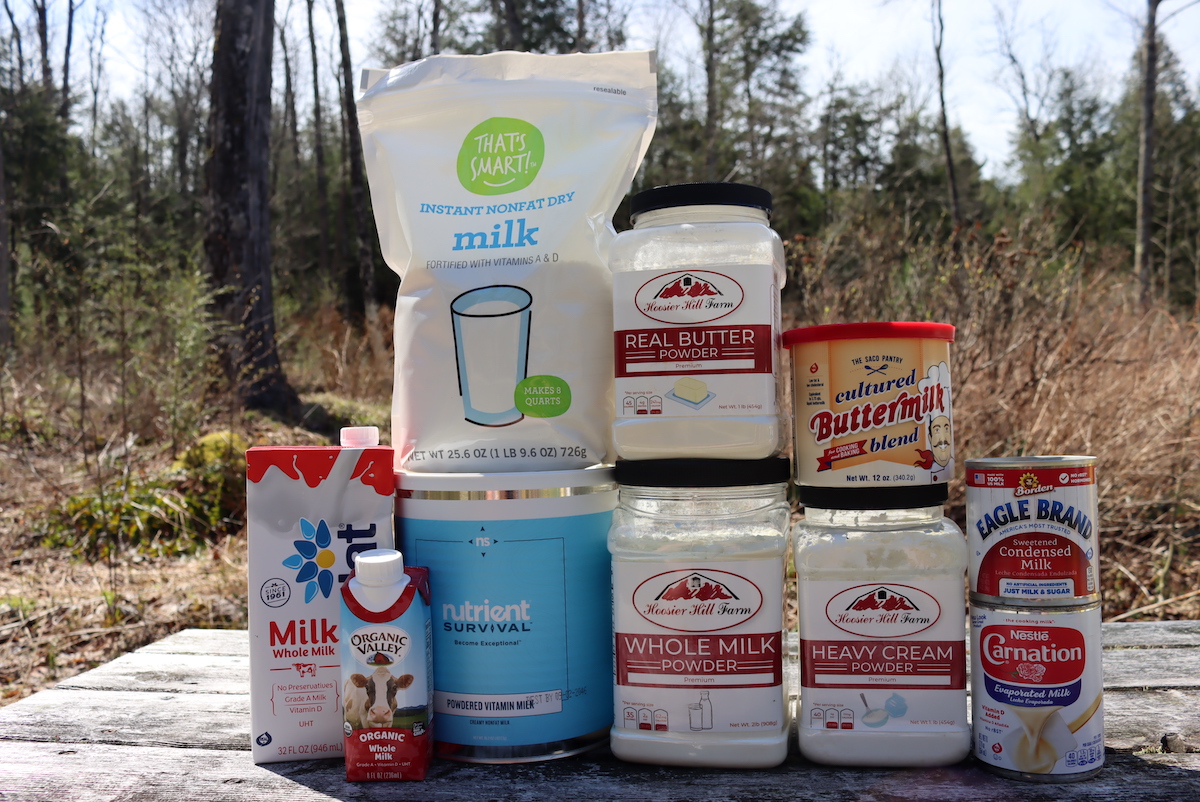
UHT Milk, or ultra-pasteurized shelf-stable milk, is probably the best option for short-term use. It’s great if you’re not planning for the apocalypse, but you just need something to fill in the gaps between grocery trips.
It’s all that’s available in many countries, especially in regions without access to dependable refrigeration (like South America and parts of the Tropics, but it’s even popular in parts of Europe).
To me, it tastes a bit “cooked” but better than most of the other options. It’s bulky because it’s ready to use at full strength (rather than just add water with powdered milk, or dilute it to use with evaporated milk).
The downside is that UHT milk only lasts about 6 months on the pantry shelf. That’s a good long time under normal circumstances, but not very long if you forget about it back there and don’t remember to use it up before it reaches its outdate.
In the past, shelf-stable milk was only available in one-quart packages, but now they’re available in single-serve “juice box” containers for packing in lunches.
Beyond that, you can also get UHT coffee creamers in little tubs, just like they use at diners.
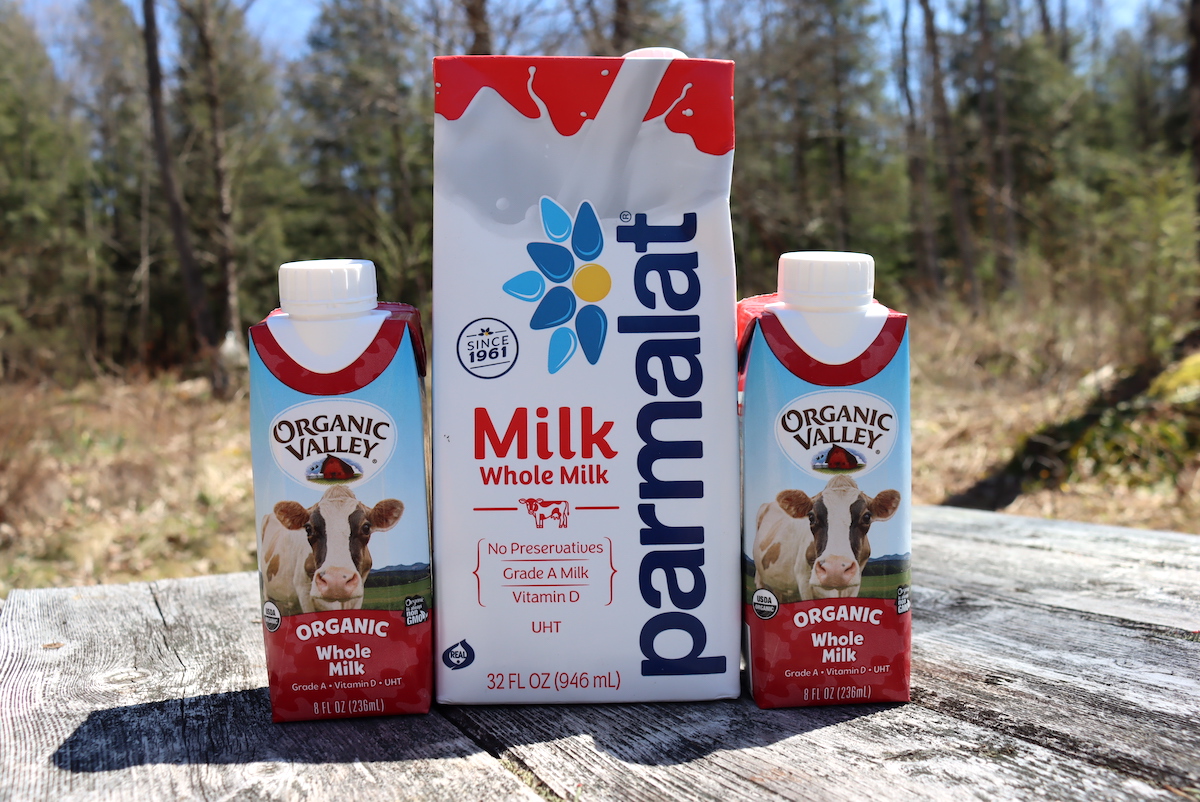
Dried milk powder is the most popular option, and it’s relatively easy to use. Just add water and shake.
In the past, dried milk only came as skim or fat-free, but the preservation technology has gotten better, and now it’s not uncommon to find dried whole milk powder. Keep in mind that dried whole milk powder doesn’t keep nearly as long as skim milk powder. Dried whole milk should be used within 12 to 18 months (unopened), while dried skim milk keeps quality for around 10 years (depending on the packaging).
You can also add dried heavy cream powder to skim milk powder to make it creamier, and otherwise, keep them separate.
Dried milk powder can be used in baking, and it often works better than fresh milk in baked goods. King Arthur flour actually specifically calls for it in their sandwich bread recipes, noting that dried milk worked much better in their trials than regular milk.
The most common complaints about dry milk are that it’s weak or watery, which can be solved by just adding more dry milk to make it stronger, or that it clumps. For the clumping issue, I’d suggest adding the dry milk slowly and whisking continuously.
It also helps to use lukewarm water, which helps the powder dissolve, and then you just cool the milk after.
The quality of the original milk and processing can also play a roll, and my favorite dried milk comes from Nutrient Survival. I’ve never had trouble getting it to dissolve in water (even cold water) and the taste is great. Since it’s packed in no. 10 cans for long-term storage, it’ll keep for at least 10 years unopened.

Dried Cream doesn’t last as long as dried milk, but it’s a good option for adding flavor (and richness) to dried skim milk. It can also be used independently in place of cream in recipes.
Beyond powdered milk and cream, there’s also powdered sour cream, powdered yogurt, and dried buttermilk powder to round out your dairy selection. I’m a particular fan of buttermilk powder, since it’s always on the pantry shelf when you need it. I don’t keep buttermilk on hand all the time, but sometimes it’s nice to be able to make a batch of buttermilk biscuits or pancakes. (I’ll talk about cheese, butter, and eggs in a moment.)
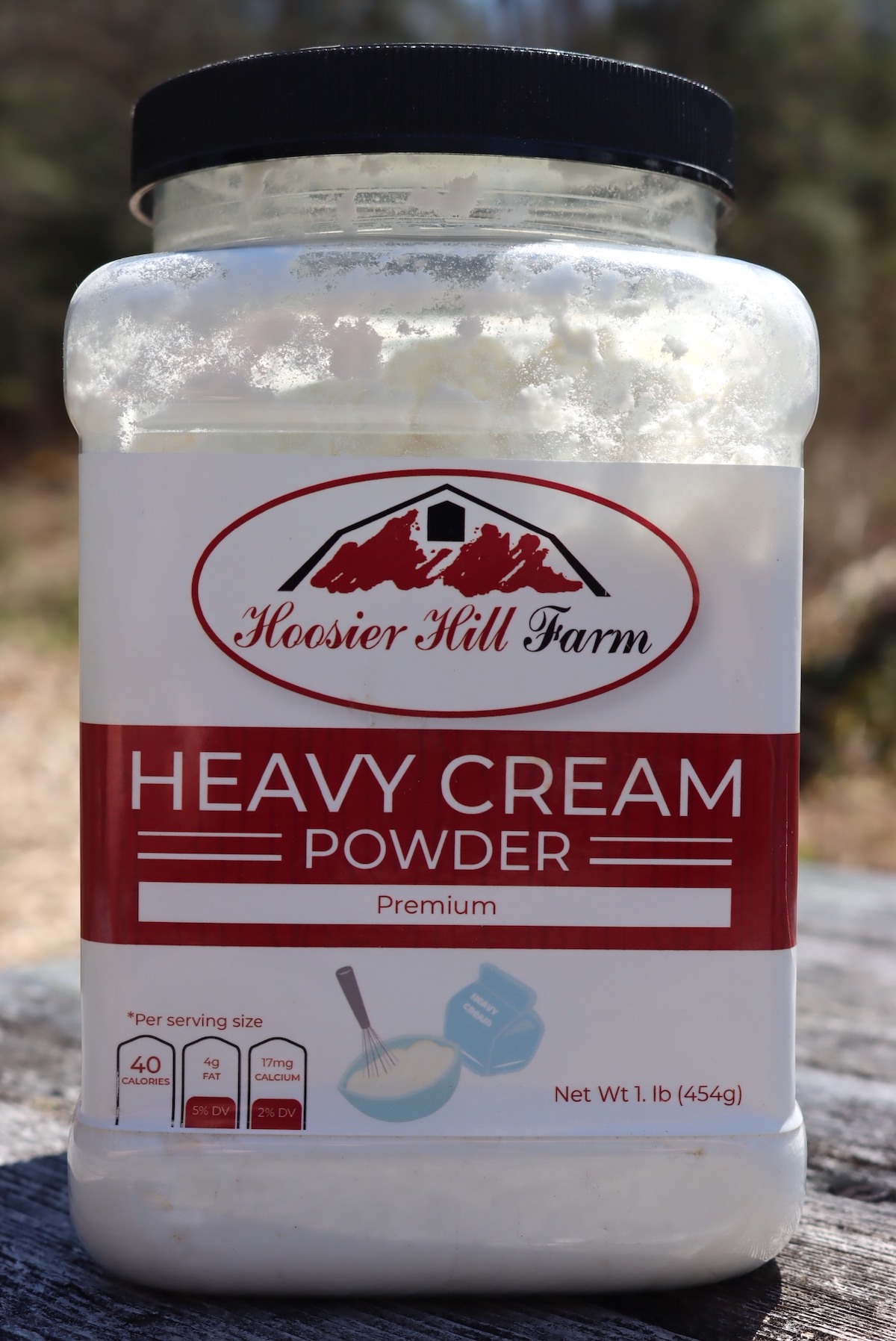
Canned Evaporated Milk is concentrated milk that’s been canned, and it tastes “cooked.” It can be thinned to make regular milk, but it will still always taste cooked.
It’s best used in recipes where you’ll be cooking the milk anyway, and where a richer milk with less water and more milk solids will actually be a benefit.
We use canned evaporated milk to make quiche, and a single can of evaporated milk to 3 beaten eggs (or the equivalent in rehydrated powdered whole eggs) makes a perfect 9” quiche. It’s traditionally used in pumpkin pie, which really is just a quiche with pumpkin and sugar instead of vegetables and bacon.
Evaporated milk also works well in homemade milk breads, like this Amish White Bread. It’s also traditionally used to make rich desserts like fudge.
Powdered milk is a better choice in general, unless you’re using it in rich baked good recipes.
Be aware that evaporated milk is very different from sweetened condensed milk. The sweetened version is thick like caramel, and it contains more sugar than milk. It’s only for making specialty desserts (though it does make a very decadent coffee creamer/sweetener).
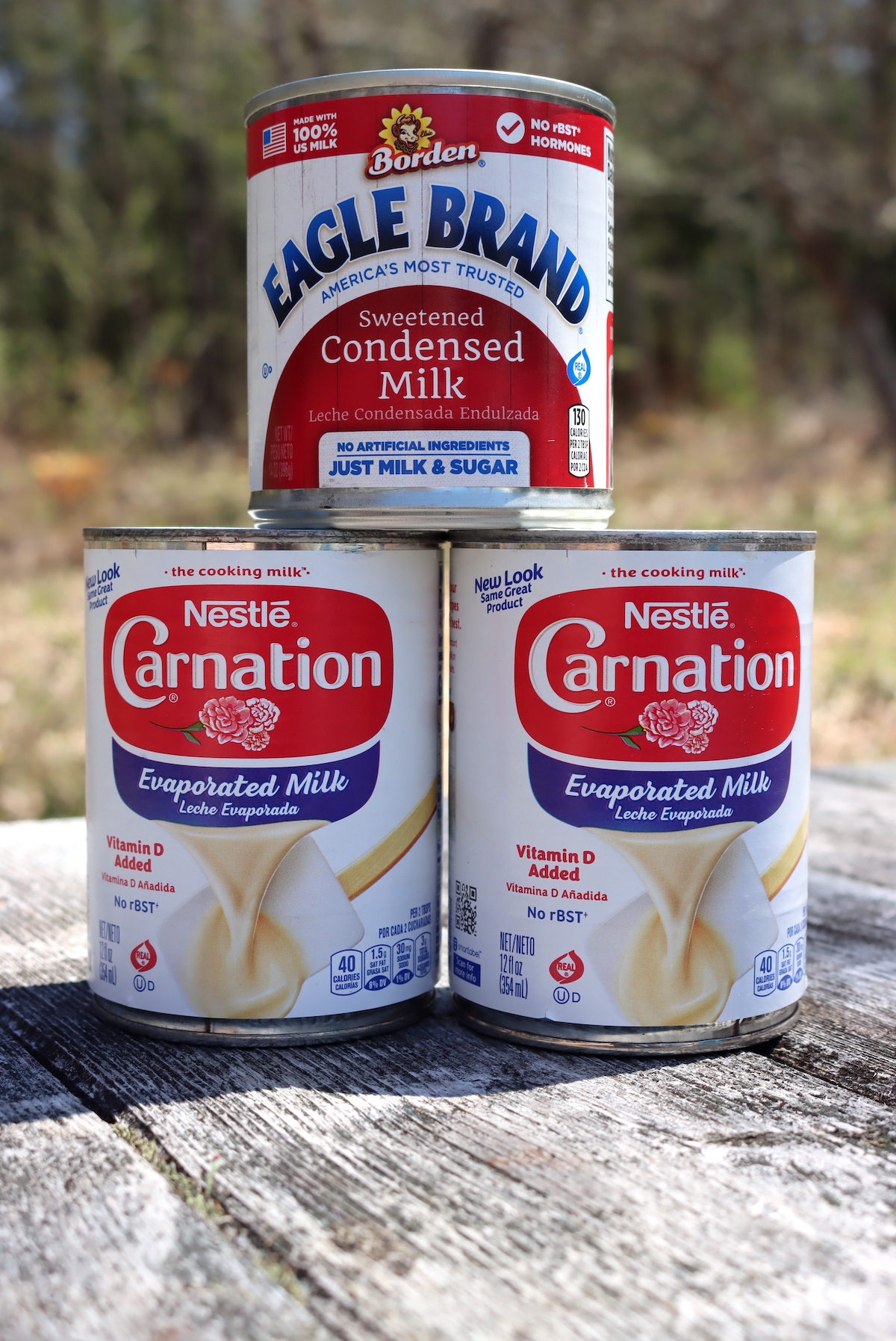
In Summary:
- UHT Milk: The best option for short-term use, as it’s the closest to regular milk in flavor. Shelf life is about 6 months unopened, so it needs to be used and rotated frequently to ensure you always have fresh stock on hand.
- Dried Milk: The best option for long-term use, anything that you’ll want to have on hand for more than 6 months. The perfect option for putting on the back pantry shelf just in case, since it has a long shelf life and it’s easy to prepare. Shelf life can be as short as 1 to 2 years (with regular grocery store packaging), or as long as 25 years with good long-term food storage packaging from a preparedness supplier. (Good choices are Nutrient Survival and Emergency Essentials.)
- Evaporated Milk: Concentrated milk in cans that works well for cooking, and can be diluted to use like regular milk. It was used historically to make homemade baby formula and was transported to the frontier without refrigeration. The flavor is not the best, but it’s good for cooking.
Shelf Stable Eggs
While storing pantry-stable milk may be the most common, shelf-stable eggs are just about as useful. It’s hard to substitute eggs in baking, and sometimes you’re short just one or two and you don’t have time to run to the grocery store. (You know, like when you’re making your kid’s birthday cake at the last minute…not that I’d know anything about that…)
Powdered eggs rehydrate easily, and they can be added directly to baked goods (muffins, pancakes, etc). You can also cook them up as scrambled eggs for breakfast, or mix them with other shelf-stable freeze-dried foods to make an omelet right from your pantry shelf.
They come in two basic types:
- Plain Powdered Eggs that will rehydrate back into raw liquid eggs, which are the most versatile and the ones you want for baking.
- Freeze Dried Scrambled Eggs are already cooked, and they’re what you’d use if you just want a quick breakfast. Just pour hot water over the top, give them 5 minutes to rehydrate, and you’ve got breakfast.
I keep both types in my pantry because they have very different uses. The plain egg powder is perfect for baking, especially when you run short of eggs and can’t get to the store. They can be made into scrambled eggs, but I actually prefer this ready-made breakfast scramble, which has scrambled eggs, seasonings, potatoes, and everything else you’d want in a breakfast.
Just add hot water, it’s ready in 5 minutes and it’s the perfect protein-rich breakfast when you’re running out the door and don’t have time to cook.
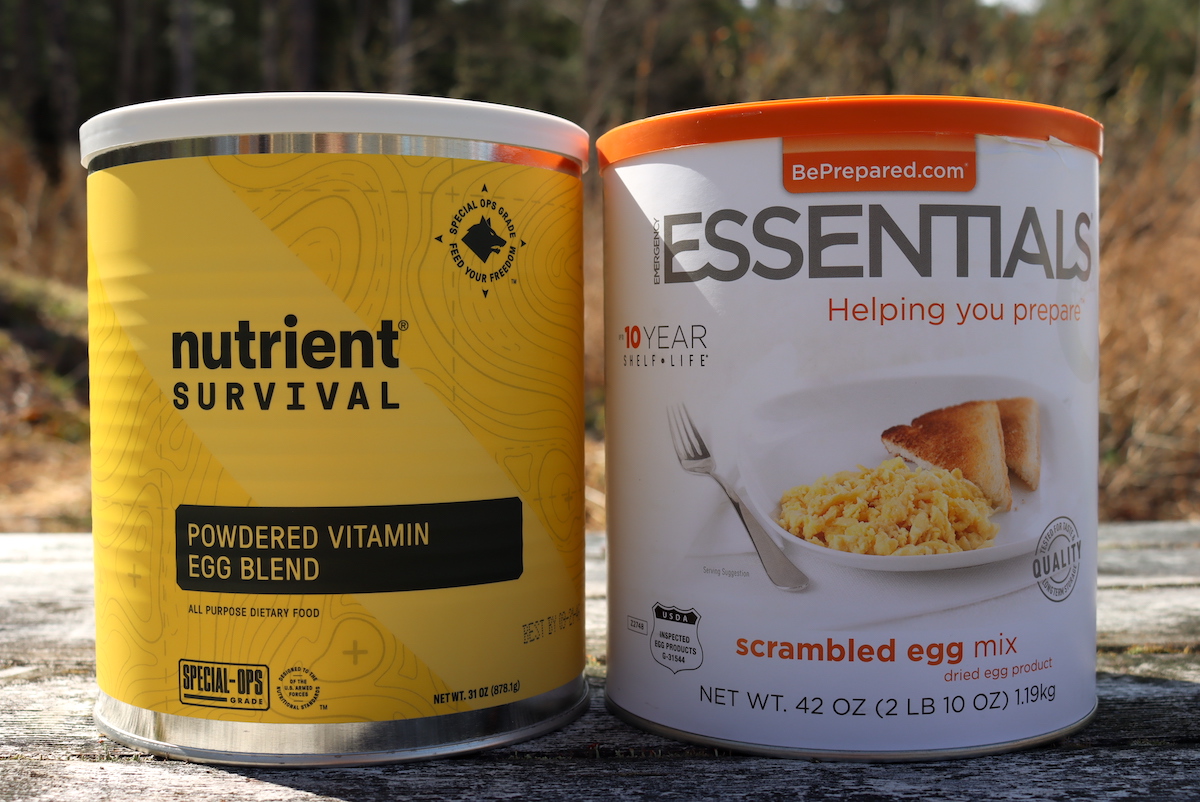
Shelf Stable Butter
Butter has a longer shelf life than milk, and it’ll even keep a while at cool room temperature. Still, it will go rancid over time, and while it does store well in the freezer, regular butter can’t be stored on the pantry shelf.
The oil (or butterfat) in butter is shelf-stable for extended periods, it’s just the milk solids that spoil. The problem is, that those same milk solids are what give butter its characteristic flavor.
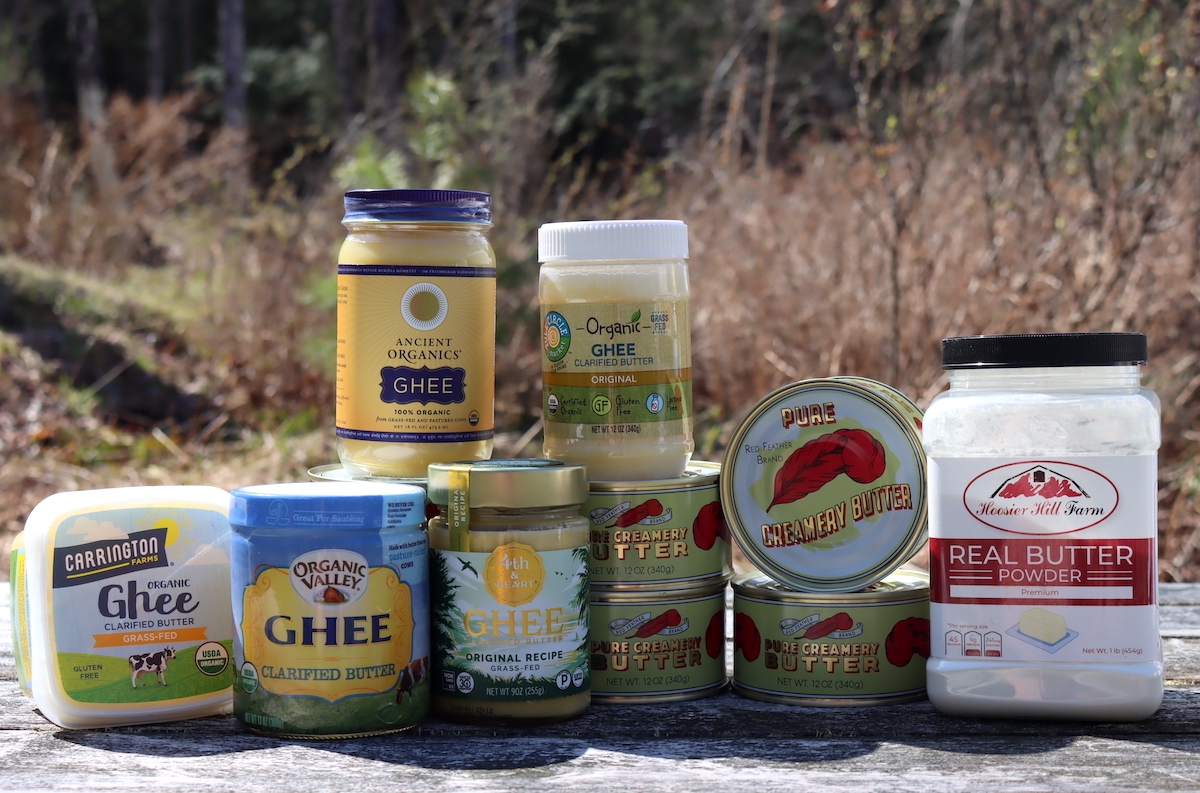
Clarified butter is butter that’s melted so it separates, and then the milk solids and liquid are removed. If properly made, it’s shelf-stable and can be stored on the pantry shelf.
It’s relatively expensive, compared to buying just plain butter.
Ghee is similar to clarified butter, but it’s usually made using traditional techniques from South East Asia that brown the milk solids (like making brown butter ghee) and give it a lot more flavor than plain clarified butter. Sometimes spices are added to make specialty ghee, but most of the time it’s just a more interesting version of clarified butter with a more “browned butter” flavor.
Real ghee is actually quite hard to source in the US. Most regular “clarified butter” is labeled ghee, as we treat the labels interchangeably here in the states. Be aware there is a difference, and if you’re at an ethnic grocery, the ghee may be a bit different than plain clarified butter. It may also contain spices, as is the case with traditionally seasoned niter kibbeh, so look at the label. This is not all that common in most stores, and just about everything sold in the US is just plain clarified butter.
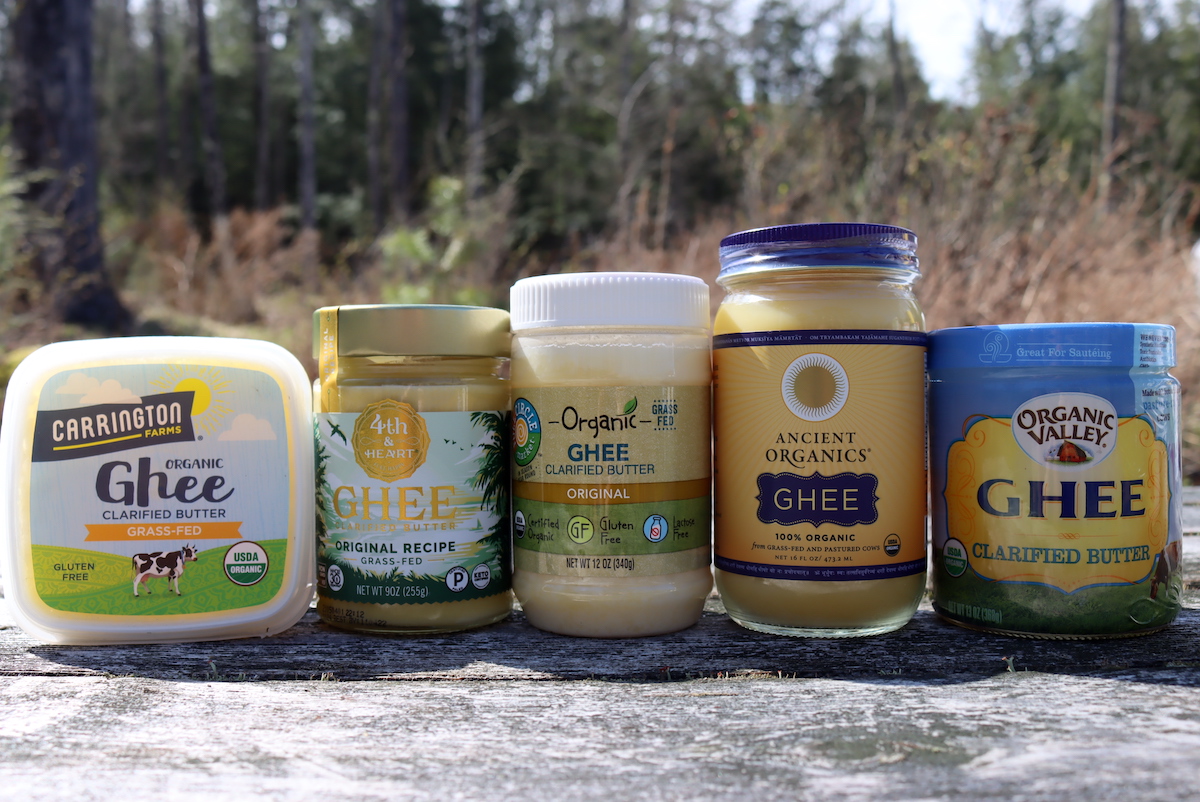
Butter Powder is basically dried milk solids, and it doesn’t contain any fat or oil. It gives the butter flavor, because it’s basically all the flavor compounds in butter dried down into a powder once the oil is removed. (There are a few powdered butters that actually contain fat, like this one from Hoosier Hill Farm, and that one will taste and cook a lot more like butter in your baking.)
If you add a bit of butter powder back into clarified butter, you’ll have the oil and the flavor together. That’s one of the better ways to keep butter on the pantry shelf, just in two parts stored as clarified butter and butter powder.
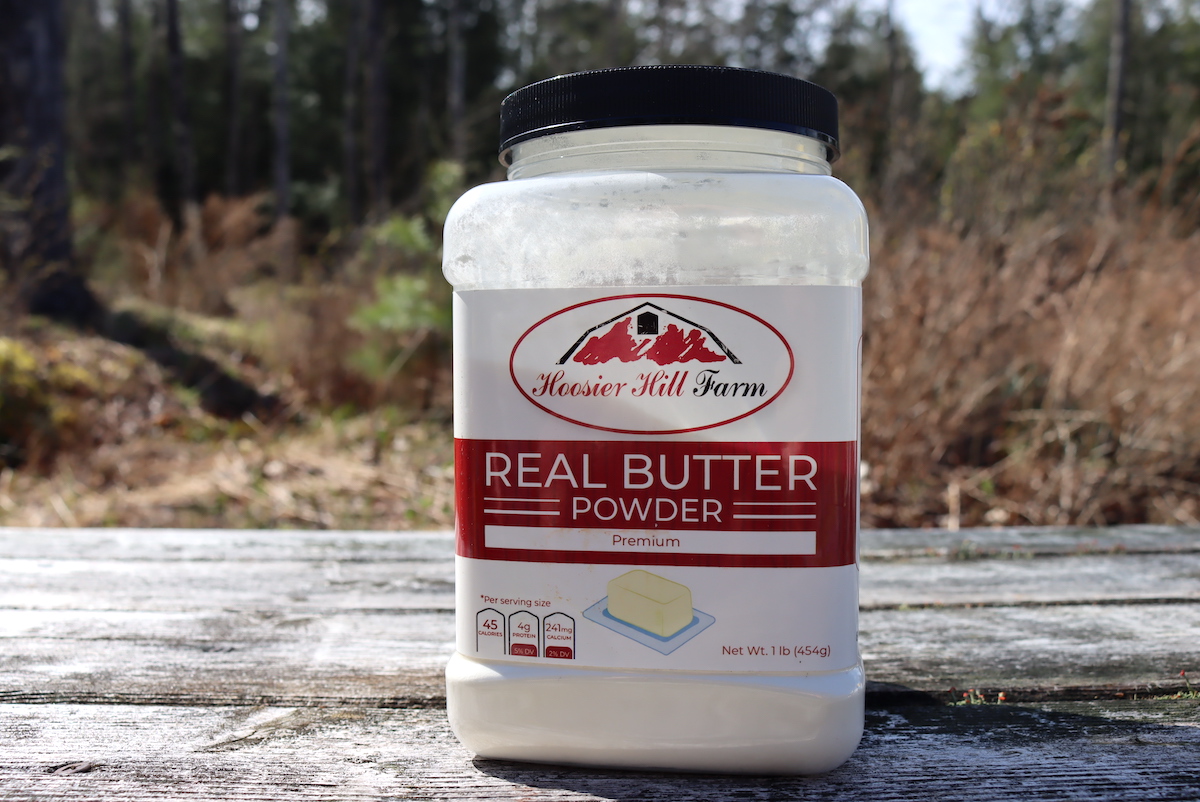
Canned Butter is available from a company that processes butter into tin cans for long-term storage, and it’s more or less exactly the same as fresh butter. The milk solids are still present, so it’s more “buttery” than clarified butter or ghee.
Contrary to what you read on the internet, you cannot can butter at home. You can’t flash heat (and then flash cool) glass canning jars like that, they’ll break. Butter can only be canned safely using industrial processes (unfortunately).
Commercially canned butter is absolutely lovely, and it was once considered a luxury product on the frontier during the gold rush. There wasn’t any fresh butter to be had, but you could buy a tin of canned butter to celebrate if you struck gold.
These days, it is still more expensive than regular butter obviously, but not ridiculously so. It’s a nice luxury to have in your preparedness pantry.
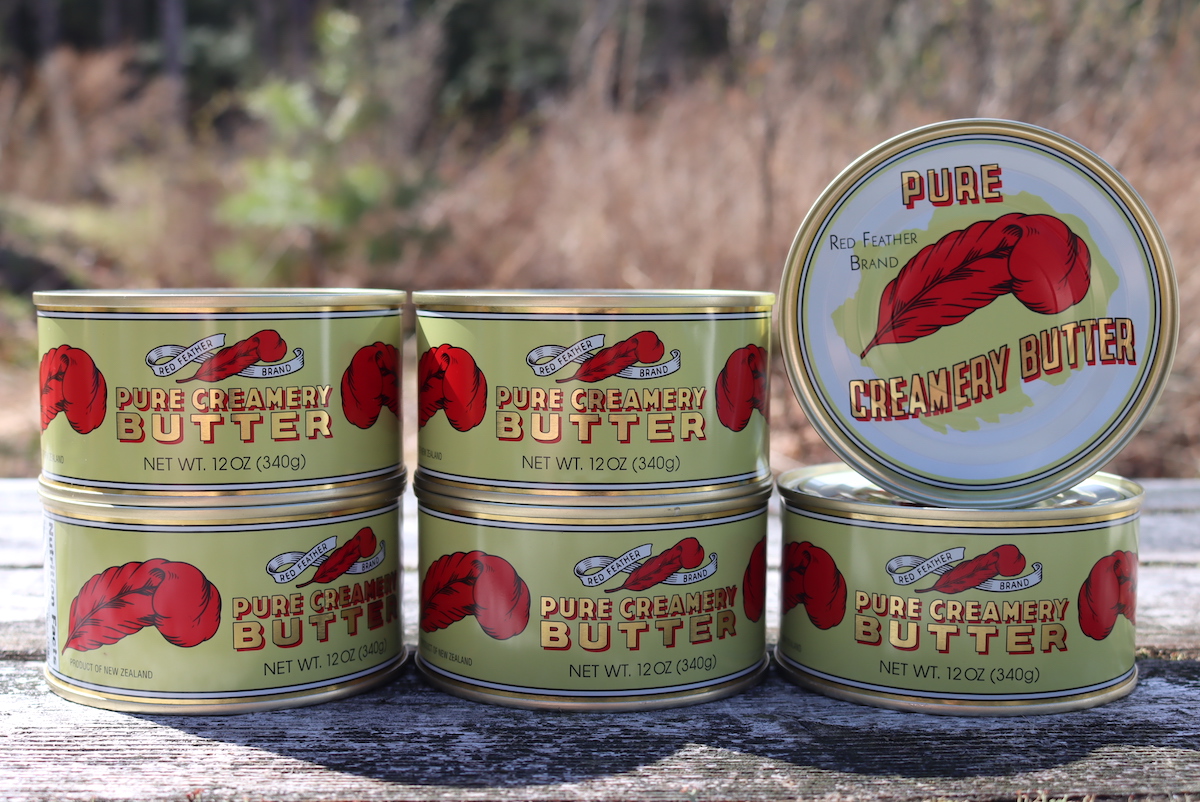
In summary:
Canned butter is a great option right in one tin, ready to use. It’s expensive, but it gets the job done.
My second choice would be a mix of clarified butter and butter powder. You can also add butter powder into other oils, like coconut oil, which is a bit cheaper than using clarified butter. You still get the flavor that way.
Shelf Stable Cheese
Cheese is the original “shelf-stable dairy” meant to give the milk longer shelf life. Many types of cheese don’t actually need full refrigeration temperatures, and they can be stored in a cool place (around 50 to 55 degrees) for weeks or months at a time.
That’s if you have the right type of cheese, and if it’s properly packaged. Well sealed (vacuum packed) hard cheese like parmesan and romano cheese are good options, as are waxed cheddars. At those temperatures, they’ll continue to mature (like in a cheese cave) and develop sharper flavors over time.
(There is a bit more information on storing and aging cheese in my beginner’s guide to cheesemaking, if you’re curious.)
Knowing exactly how to do this right can be tricky, and it’s impossible in hot climates. It’s actually pretty difficult in summertime anywhere, even here in Vermont, unless you have a root cellar.
For the average person, a true shelf-stable cheese is a lot easier to manage, because you know it’s perfectly fine to eat even if the power’s been out a long time.
Kraft parmesan cheese is shelf-stable (until opened), and it’s good for adding flavor to stored pasta and sauce.
Dried cheddar powder makes popcorn taste amazing, and it’s a much cheaper way to store easy mac and cheese. The powder is more or less exactly what’s in those little packets inside a box of mac and cheese, but a lot cheaper and more versatile.
Store the cheddar powder separately and you can use it on anything, and then just buy regular elbow pasta (at about 1/3 the cost of boxed mac & cheese).
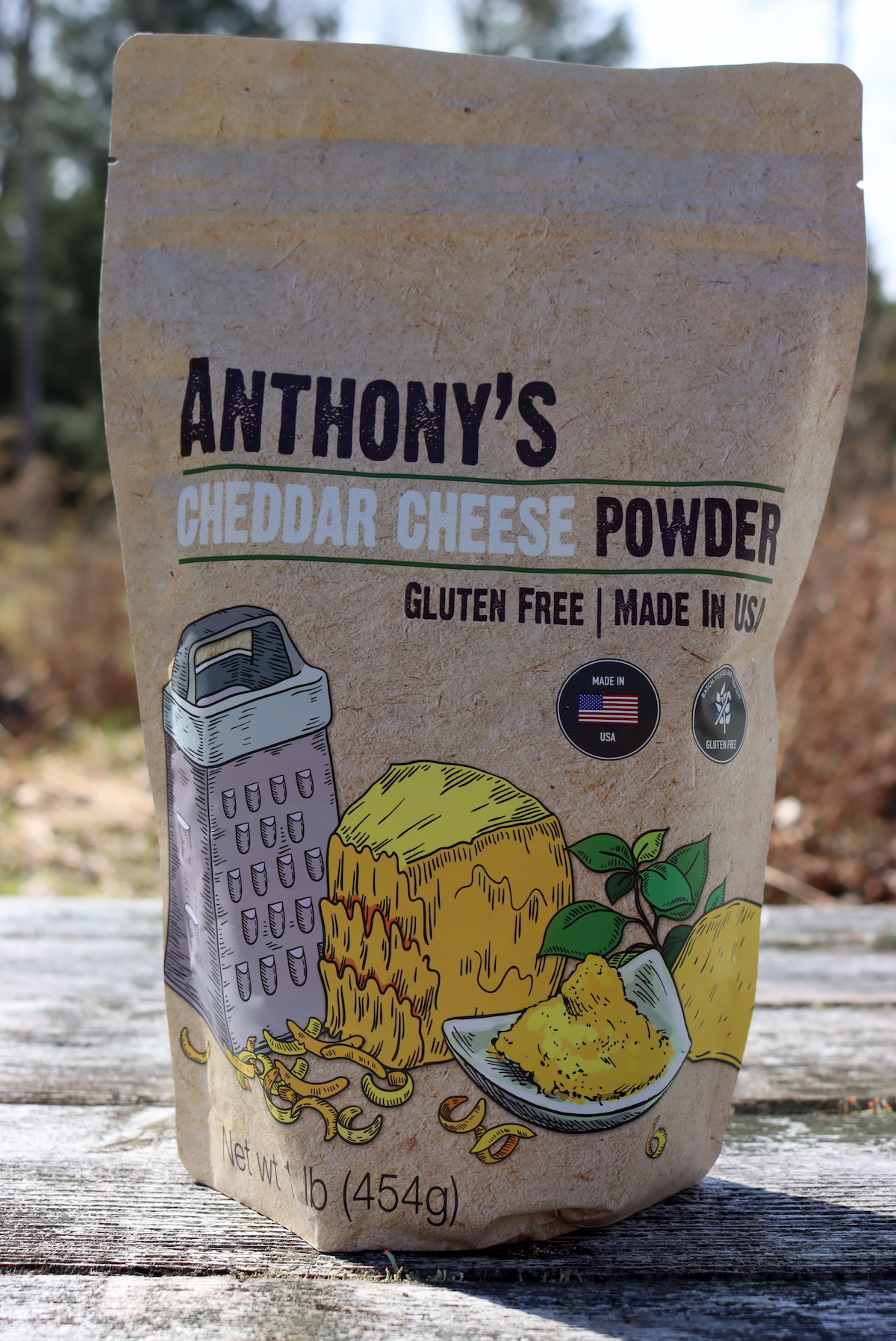
Freeze-dried cheese is exactly the same as fresh cheese once it’s rehydrated. While most freeze-dried food manufacturers made it prior to 2020, it’s hard to find now as they’ve mostly shifted to pre-made freeze-dried emergency meals (rather than individual ingredients).
At this point, it’s only available from a single supplier. The most common types are shredded freeze-dried cheddar, which is great on top of anything, and shredded freeze-dried mozzarella.
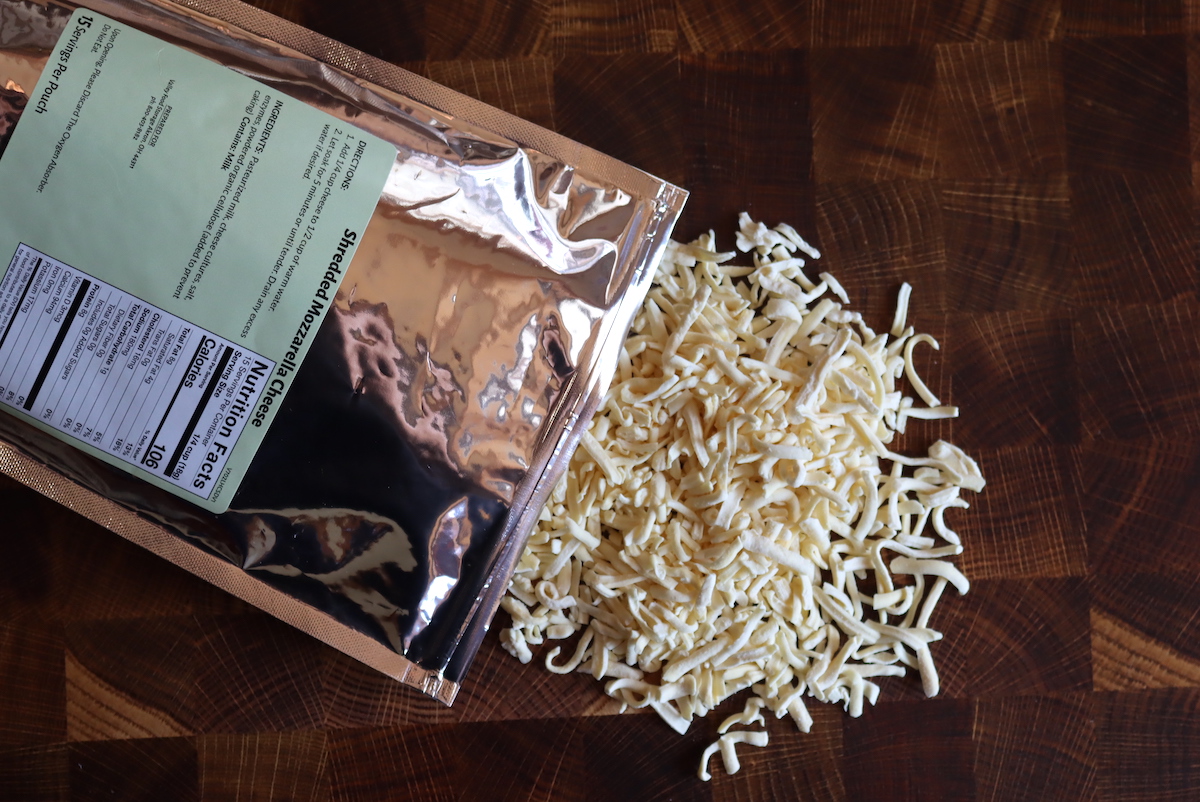
You can make a really tasty homemade pizza from all shelf-stable pantry ingredients if you have freeze-dried mozzarella. The crust is made from flour, salt, olive oil, and sourdough starter (or yeast which stores 2-3 years in the freezer). The sauce comes from freeze-dried tomato chunks or tomato powder, or you can just use home-canned tomato sauce instead (which lasts 18 months in the jar).
You can even top it with freeze-dried sausage crumbles and freeze-dried bell peppers, for an old-school supreme.
Canned cheese is another option, but it’s incredibly processed and salty. If you’re ok with that, great, but it’s not the best choice in my opinion.
You can also make cheese with powdered milk, believe it or not. You just rehydrate the milk powder and then use it in cheesemaking recipes. It works best with simple cheesemaking recipes like homemade paneer, and you can also make mozzarella with dried milk.
Shelf Stable Meat
There are a couple of ways to keep meat right on the pantry shelf, and some are better than others. Frozen meat is obviously the most versatile, but anyone that’s lost a chest freezer to an extended power outage knows that freezing meat is not the most dependable in an emergency.
My shelf-stable meat is home-canned meat, which must be canned in a pressure canner. The canning process basically braises the meat in its own juices, leaving it tender and delicious right in the jar.
It’s fully cooked, and you can literally pop off the lid and eat it with a fork. (It’s obviously better reheated.)
With a pressure canner, you can also put up meal in jar recipes, like any of these soup canning recipes.
If you’re not up for home pressure canning, you can also buy canned meat for long-term storage. I’ve tried some of the commercially made stuff, and it’s incredibly tasty. Like grandma’s pot roast, tender and delicious. (It’s more expensive than doing it yourself, but you don’t have to fuss with pressure canning.)
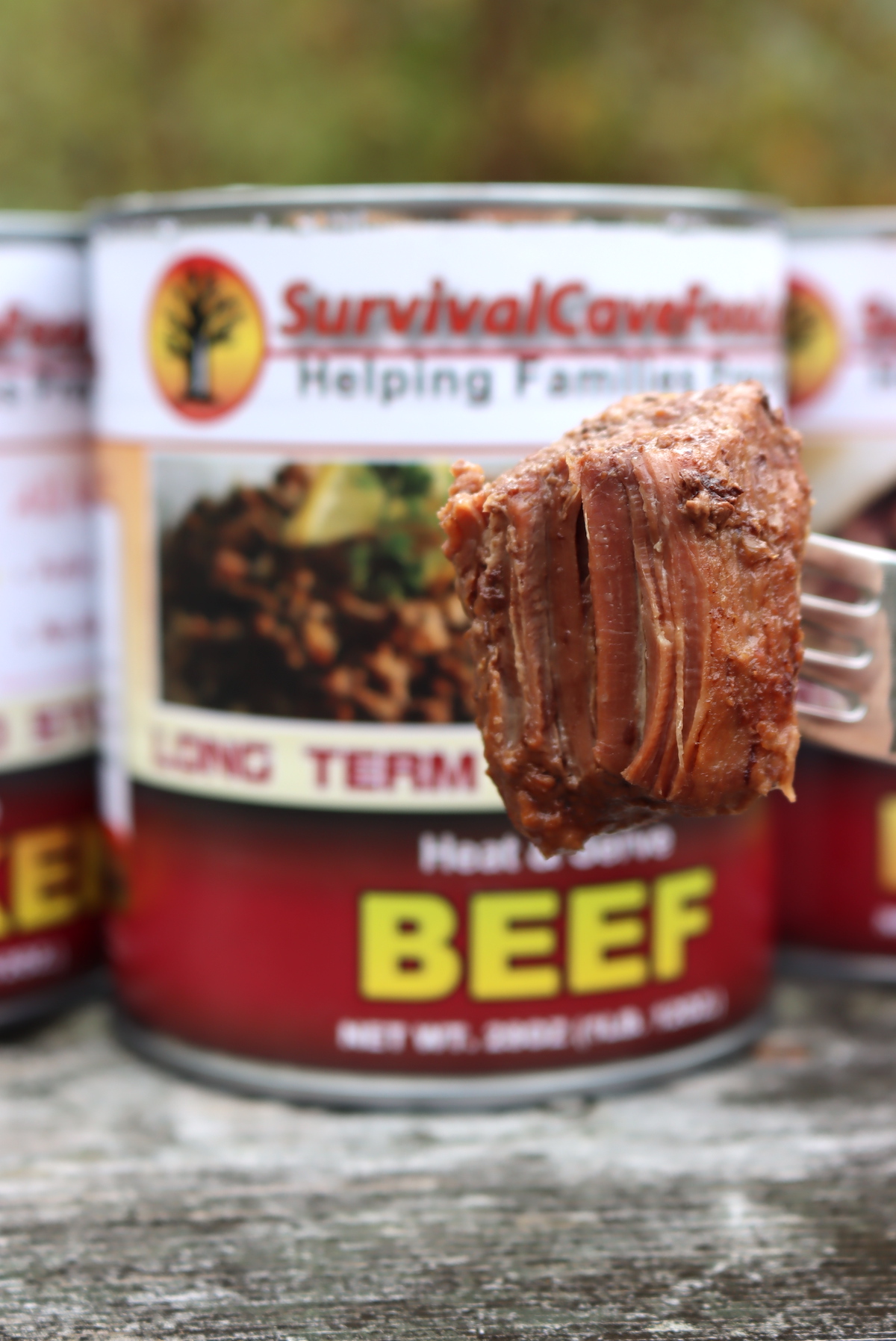
Freeze-dried meat is another great option, and once rehydrated it’s pretty much exactly the same as fresh meat. I’ve even written up a guide to cooking with freeze-dried meat, since it’s such a versatile addition to your long-term food storage.
Unlike canned meat, freeze-dried meat can survive freezing temperatures, it’s a good option in long-term emergencies where you might not be able to keep your stocks from freezing during winter power outages (or stored in an off-grid cabin somewhere).
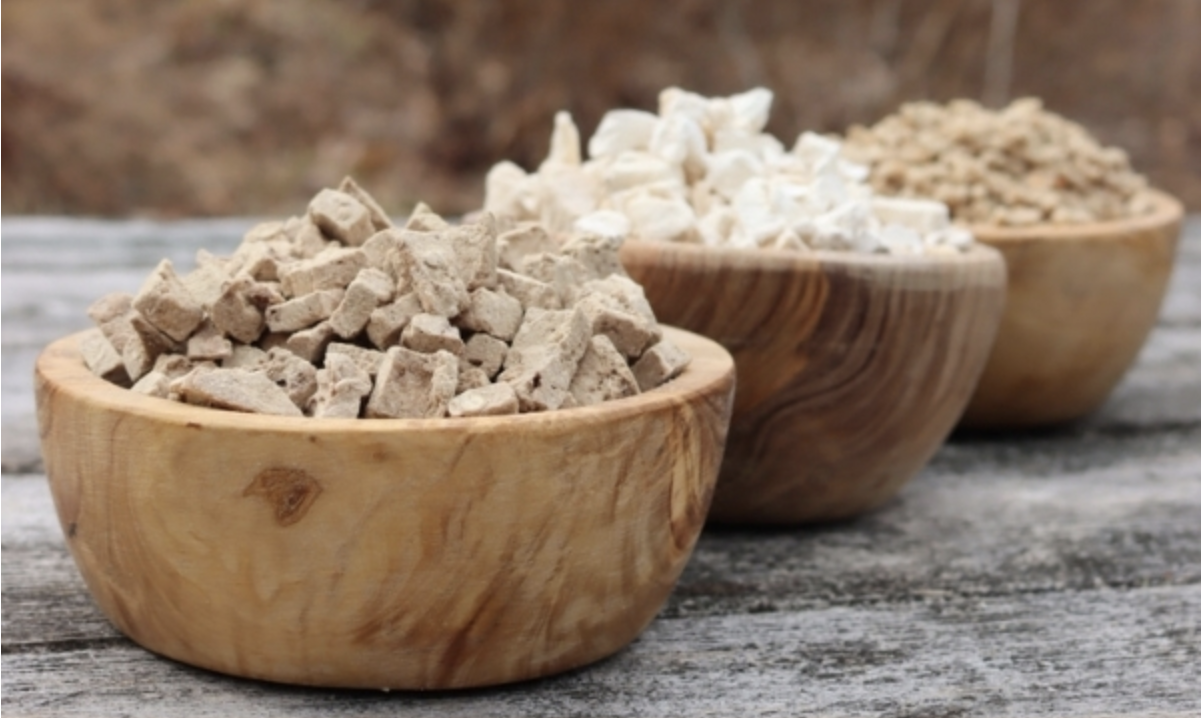
Dried meat, like jerky, is another option. You can eat it plain, or rehydrate it in soups. If it’s well seasoned, jerky is delicious, but you’ll want it plain for cooking.
It’s not the best for cooking, since it doesn’t rehydrate nearly as well as freeze-dried meat. Dehydrated meat will always be rubbery when rehydrated.
Salt cured meat is one way they put up meat historically, but it only really keeps well if kept cool (like in a root cellar). If kept at actual room temperature (or in warm climates) then you need so much salt that the meat is unpalatable. It needs to be soaked repeatedly to remove as much salt as possible, and then it’s still only good in small amounts (diluted in a big pot of stew).
If you have a way to keep meat cool (but not necessarily refrigerator cold), then curing meat (or storing cured meat) might be an option. I have a few beginner recipes including:
- Cured Pork Loin (Lonzino)
- Cured Pork Belly (Panchetta)
- Cured Pork Jowl (Guanciale)
- Cured Duck Breast (Duck Prosciutto)

Pantry Stored Fruit for Emergencies
Fruit is one of those things that’s nice to have, and most parents know that their little ones are much happier with access to fresh fruit. If you can’t access the grocery store in an emergency, fresh fruit will spoil quickly.
Freeze-dried fruit keeps for 25+ years and is absolutely delicious. My kids are especially fond of:
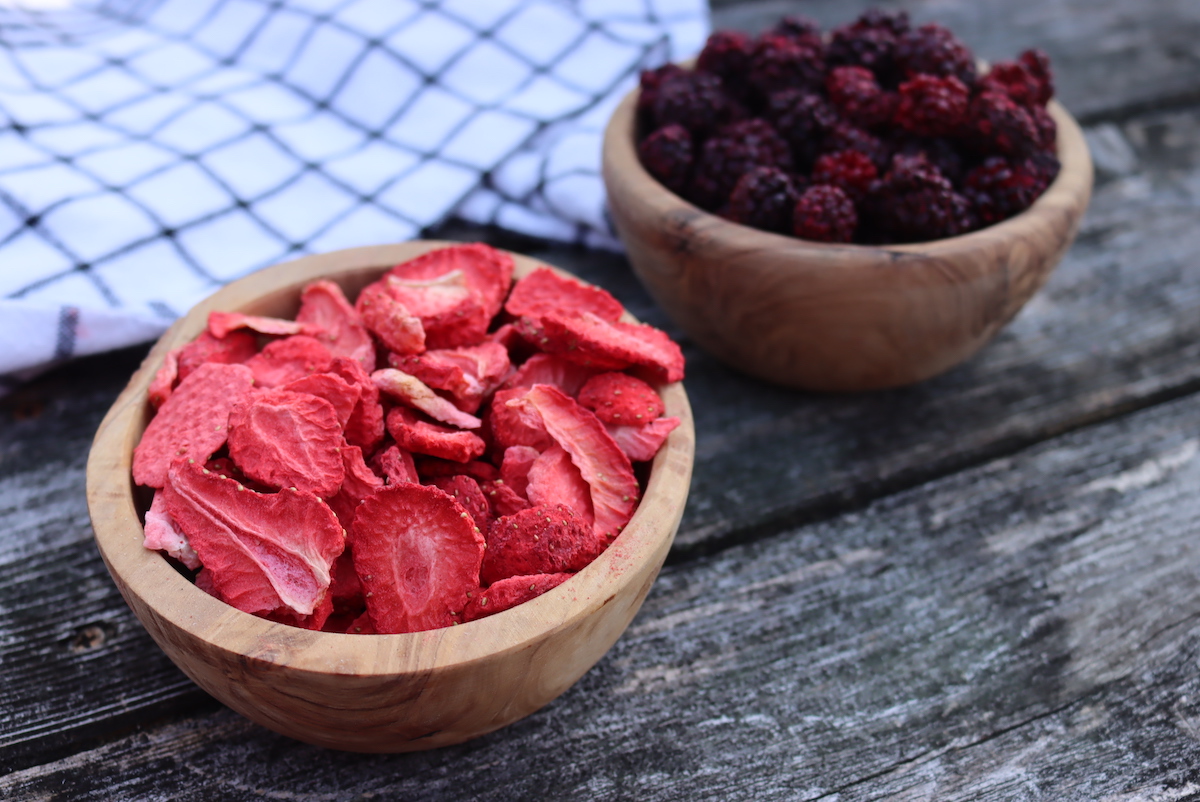
Dried fruit is also tasty, but not quite as good as freeze-dried.
The drying process carmelizes some of the sugars inside the fruits, so it’s never quite the same flavor as fresh fruit. (Freeze-dried fruit, on the other hand, is just like fresh fruit but without the water.)
Canned fruit is also an option, whether it’s storebought or water bath canned at home using fruit canning recipes. The downside is the fruit tastes cooked, which is not a problem with some types of fruit, but just know it’s not going to taste fresh.
The other problem is that it’s going to have sugar added. Canning fruit in plain water cases the flavor (and natural sweetness) to leach out into the canning liquid, so it’s watery and washed out. You have to add some sugar to protect flavor, and if you can your own you can use extra light syrup (which is just enough to maintain the natural sweetness of the fruit without adding any extra sweet).
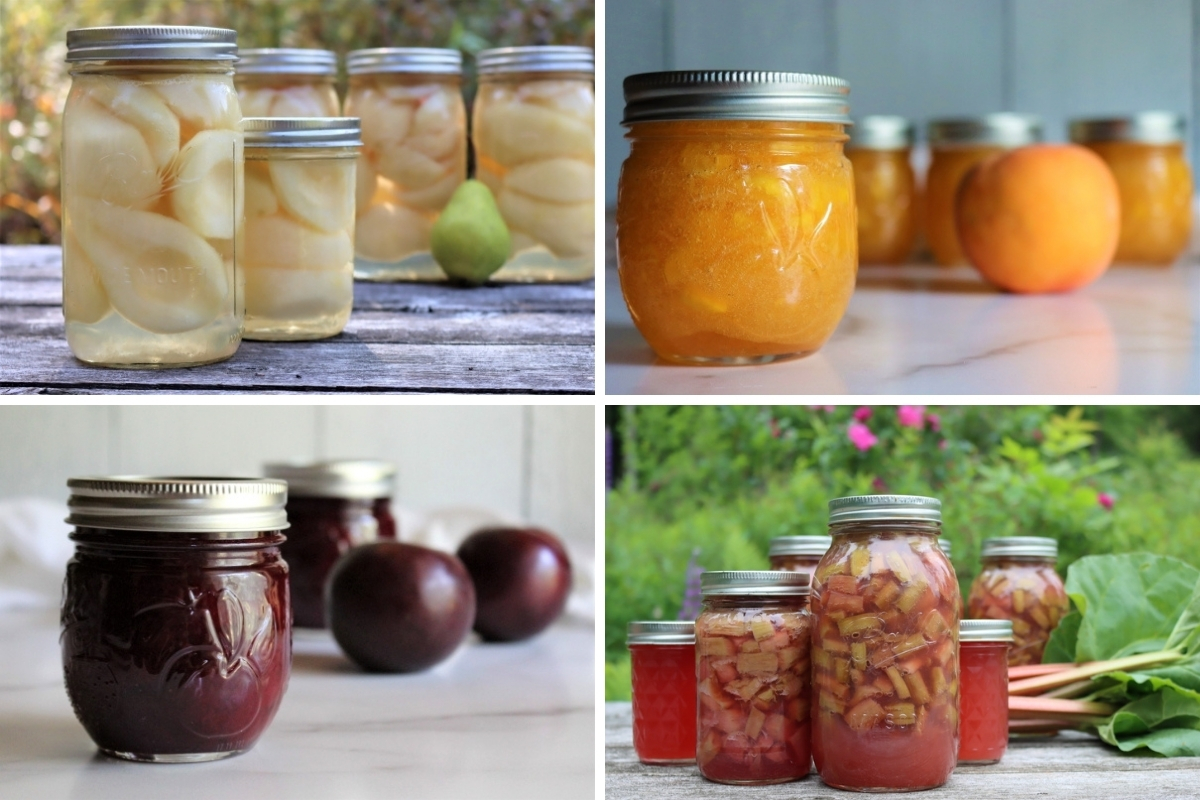
Pantry Stored Vegetables for Emergencies
The obvious way to store vegetables on the pantry shelf is canned veggies. They’re readily available at the grocery store, and relatively inexpensive.
You can also use a pressure canner to process them at home using any of these vegetable canning recipes.
Anyone who’s compared fresh veggies to canned ones knows that canned vegetables aren’t nearly as good. Still, there are some that work better than others. If you’re canning yourself, I’d suggest:
If you’re hoping for something with a more fresh flavor, I’d suggest freeze-dried vegetables. Like freeze-dried fruit and meat, they last 25+ years and rehydrate back to their original flavor and texture quickly.
My favorites are:
- Freeze Dried Diced Potatoes
- Freeze Dried Onions
- Freeze Dried Peppers
- Freeze Dried Mushrooms
- Freeze Dried Tomatoes
- Freeze Dried Peas
- Freeze Dried Carrots
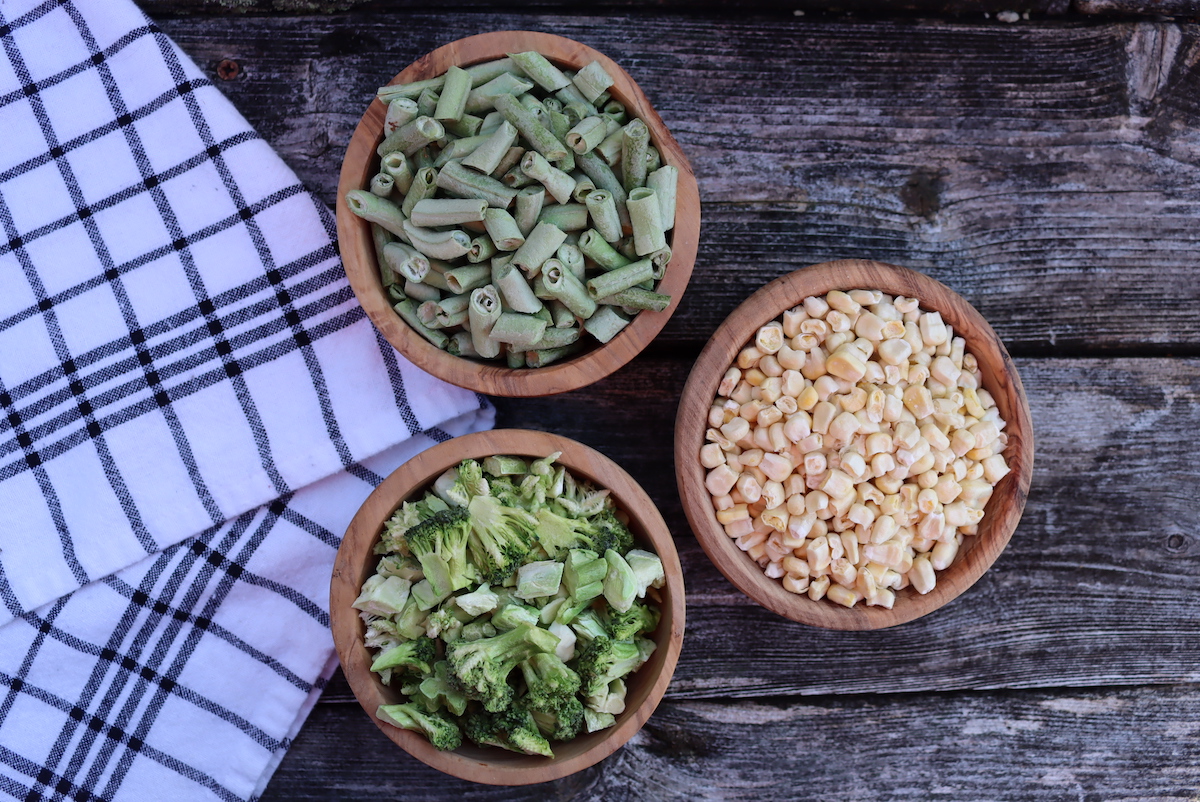
There are also plenty of dehydrator recipes for vegetables, and that works fine if you’re dehydrating vegetables for soups. They’re not great for use as a side dish, and they’re not nearly as versatile as freeze-dried veggies.
Shelf Stable Food List
So what’s in my pantry?
We produce a lot of our own food here, so I’ve got plenty of home-canned meat, fruit, and vegetables. That’s plenty to keep food on the table when you add in our other regular pantry ingredients like flour, rice, beans, and sugar.
Still, I always feel better when I’m able to feed my family their favorite comfort foods (no matter what’s going on in the world).
I also keep:
- Dried Milk Powder
- Dried Cream Powder
- Buttermilk Powder
- Clarified Butter
- Cheddar Cheese Powder
- Dried Egg Powder (For cooking)
- Freeze Dried Breakfast Scramble (For scrambled eggs)
- Freeze Dried Fruit (because it’s delicious)
Beyond that, we always have MREs on hand for emergencies where cooking is tricky. (I’ve written up a review of the best MRE’s and how to cook them, we’ve tried them all.)
For longer-term emergencies, we also keep freeze-dried emergency meals on hand, and their long shelf life gives me peace of mind. I know we always have full meals in the house, even if our pantry is at a low ebb.
My favorite emergency food suppliers are Valley Food Storage and Nutrient Survival, but you can read my detailed review on all the best emergency food kits if you’d like to know specifics from every company available.
Preparedness Resources
Looking for more preparedness resources?
- Best (and Worst) Emergency Food Suppliers
- How to Prepare for WWIII
- Survival Gardening: Our Real Life Dry Run
- Best MRE Meals (Meals Ready to Eat)
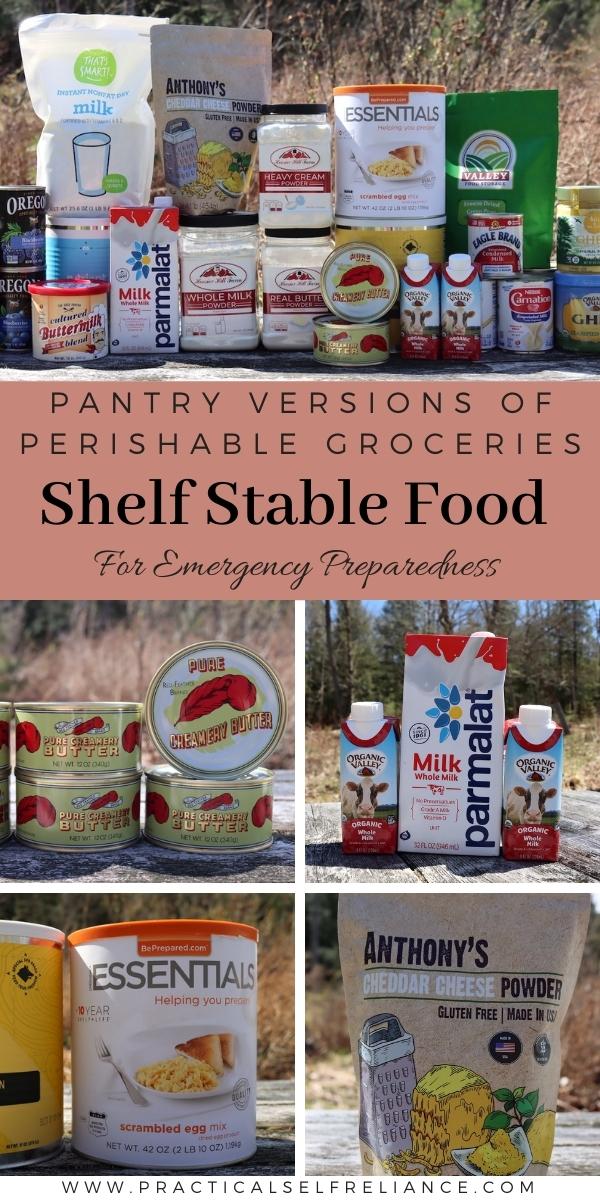
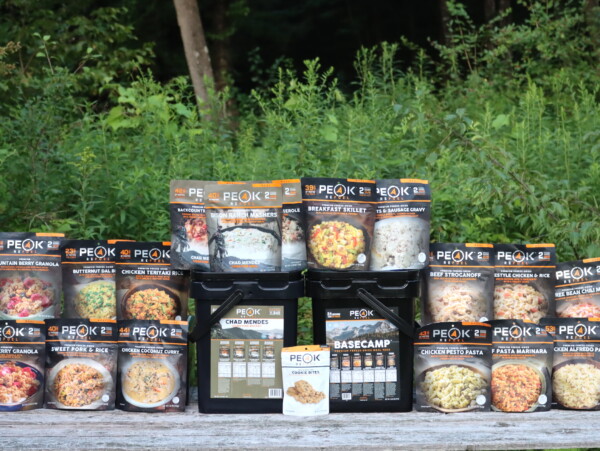
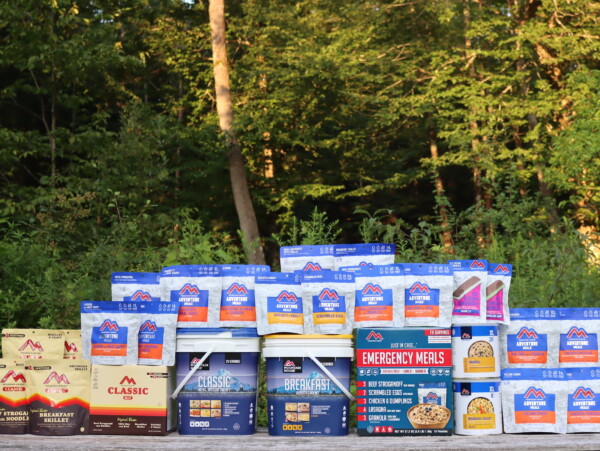
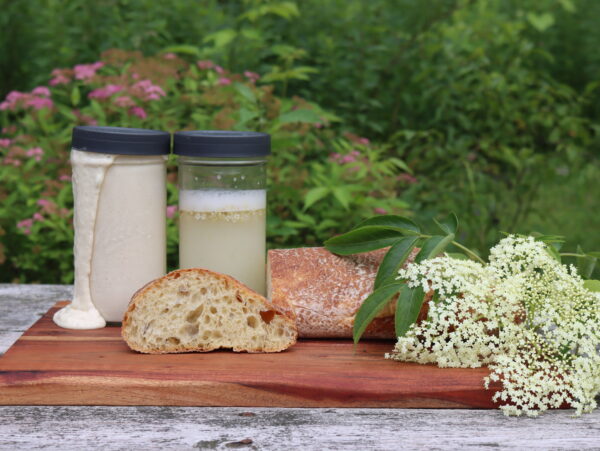
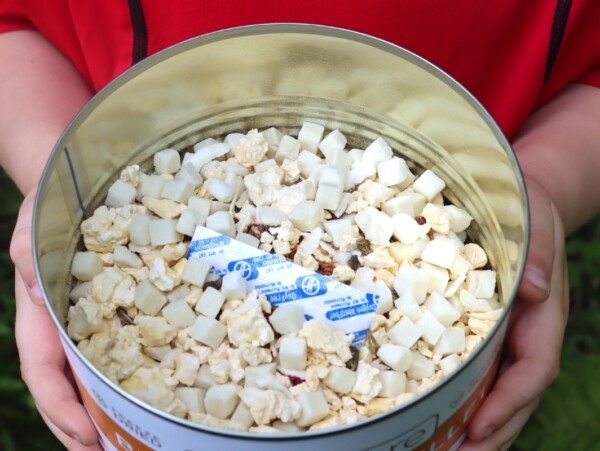










Hi
I was googling for content about Perishable food When i came across your excellent resource page.
I just wanted to say that your page helped me, I would have never found the resource with out it.
Either way, thanks for putting together your list of resources. And have a great day.